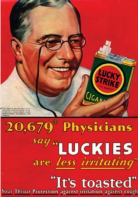Tobacco Marketing: A Look at Manipulation, Misdirection, and Adaptation in Response to Public Perception
Created by Aria Smith on Fri, 07/01/2022 - 01:00
Part of Group:
This timeline shows how the marketing of tobacco products, especially cigarettes, has been drastically altered in response to the changing American perception of smoking. With claims of smoking causing health problems, tobacco companies needed to change their marketing techniques in order to manipulate public perception. One can see this manipulation by viewing the marketing technique of cigarettes after times of rising health concerns, such as the banning of cigarettes in multiple states and the cancer scare years. Tobacco companies knew how important the current public perception was to sell their products and used this knowledge to find marketing solutions that would ease the public concerns. Many different instances of changing public perception of smoking will be shown in this timeline, as well as how tobacco companies responded with their marketing.
Timeline
Chronological table
| Date | Event | Created by | Associated Places | |
|---|---|---|---|---|
| circa. 1890 to circa. 1900 |
Increasing Popularity of Cigarettes Across AmericaIn the article “The 1964 Surgeon General's report and Americans' beliefs about smoking”, cigarettes are described as becoming incredibly popular across the country between the 1890s and early 1900s (Marshall 253). The marketing for cigarettes was everywhere, from newspapers to favorite celebrities smoking a certain brand, which made everyone want to take part in smoking. The public perception of smoking was very favorable at this time, which made the marketing of cigarettes easy and helped bring in large profits. |
Aria Smith | ||
| circa. 1900 to circa. 1920 |
Cigarette Bans Across the CountryCigarettes receiving mass popularity in the early 1900s led to many being concerned that smoking may not be healthy. Warnings of cancer and stillbirths were spread across the country by anti-tobacco movements, which causes multiple states to enact bans on cigarettes. Nearly all states banned the sale of cigarettes to minors, while multiple banned the sale to adults (Marshall 253). This is the first time the American public was made aware of what cigarettes can do to one's health, which caused the perception of smoking to begin to change. With this change of perception, the tobacco companies had to begin using manipulative marketing methods to distract the public. |
Aria Smith | ||
| circa. 1920 to circa. 1927 |
Cigarette Bans Begin to be RepealedThe state bans and efforts brought by the anti-tobacco campaigns made cigarettes more popular, and more of a symbol, than ever. Campaigns didn't last for long and the state bans started being repealed in the mid-1920s (Tyrrell 783). |
Aria Smith | ||
| 1927 |
Last Cigarette Ban RepealedThe final state to repeal its ban of the sale of cigarettes was Kansas in 1927 (Marshall 253). |
Aria Smith | ||
| 1930 |
First Physician Cigarette Advertisement PublishedTrying to eliminate and distract the public away from health-related concerns about smoking, tobacco companies started using physicians in cigarette advertisements. These advertisements were meant to manipulate the public perception by using someone they trusted to have their health as number one priority. Anxiety levels of the public were reduced due to the physician advertisements because they thought that if a reassuring doctor approved of smoking cigarettes it must not be as harmful as some were claiming it to be. Along with physicians in advertisements, health-related claims were also added to several cigarette advertisements. A common example of a health-related claim in a cigarette advertisement was “20,679 Physicians say “Luckies are less irritating”" (Gardner 223). Image from https://www.healio.com/news/hematology-oncology/20120325/cigarettes-were... |
Aria Smith | ||
| 1950 |
Release of Five Major Studies about the Harmful Effects of SmokingFive major studies from the Journal of the American Medical Association, the British Medical Journal, and Cancer Research were published in 1950 connecting the smoking of cigarettes to lung cancer (Marshall 255). These studies put an end to physicians in cigarette advertisements as they could no longer be connected to something extremely unhealthy. Tobacco companies had to find another marketing technique to manipulate the public as they could no longer use physicians. This would come to be difficult as the public perception of smoking was changing yet again due to more and more studies being published relating the smoking of cigarettes to adverse health effects. |
Aria Smith | ||
| circa. 1950 to circa. 1954 |
Advertisements Using "Natural"The public began taking smoking-related health concerns seriously after receiving much media attention and the publishing of countless scientific studies. To manipulate the public away from their concerns tobacco companies started describing the attributes of their products as "natural" (McDaniel 7). This was meant to make buyers believe cigarettes were not as harmful as they were seeing in the media. Along with making buyers doubt the health concerns of smoking, this marketing technique was also used to make the public believe certain brands of cigarettes were healthier than others because a "natural" cigarette appeared less harmful. Image from https://csts.ua.edu/women/feminine/
|
Aria Smith | ||
| 1953 to 1954 |
Cancer Scare YearsDuring these years, more and more of the public was beginning to realize the harmful effects of smoking cigarettes from the scientific studies that were published (Marshall 257). The public perception was slowly starting to change, and this was the momentum needed to continue changing the perception of smoking in the minds of the public.
|
Aria Smith | ||
| 1954 |
Frank StatementThe view of tobacco companies in the minds of the public was not favorable after the publishing of scientific studies proving smoking was unhealthy. People were viewing tobacco companies as untrustworthy, and to combat this, the companies created the Frank Statement to diminish the concerns about smoking. This statement was an advertisement created by the tobacco companies to ease the minds of the public by stating they would conduct their own research to find if smoking cigarettes was harmful, as well as create doubt about the scientific studies (Marshall 255). |
Aria Smith | ||
| 1955 |
End of Health-Related Claims in Cigarette MarketingDue to numerous studies connecting smoking to negative health effects, the Federal Trade Commission (FTC) created a voluntary agreement with the tobacco industry that banned cigarette advertisements from using any health-related claims (Marshall 260). The tobacco companies were no longer able to put anything regarding health in their cigarette advertisements, which stopped the companies from putting false claims that their brand was healthier or had more benefits than another brand. This agreement helped get rid of many of the misleading claims about tobacco that the public still believed in. |
Aria Smith | ||
| circa. 1955 |
Anti-Tobacco Education in SchoolsAfter the release of countless studies linking smoking to adverse health effects, many health advocates chose to enact change by sending materials to schools around the country to teach the youth about the risks of smoking (Marshall 258). Young adults and teenagers became most likely to recognize the dangers of smoking as their perceptions were negative from what they had been taught. These warnings presented in schools were incredibly helpful in modifying the perceptions of smoking in the minds of the younger generations. |
Aria Smith | ||
| 1964 |
Release of Surgeon General's Report
The first Surgeon General's report on smoking marked the smoking of cigarettes as the central cause of cancer of the larynx and lungs, as well as the cause of numerous other health conditions (Warner 5). This report got mass amounts of media attention to the point where almost every American had either read about it or heard of the news. Due to the media attention, a massive shift in the public perception of smoking occurred rapidly. Along with this, the report paved the way for action at the national level to reduce the health burden of tobacco products (Adams 1). This report made it incredibly hard for the tobacco companies to use their previously successful marketing techniques as the public knew with certainty the harms of smoking. There was no way for any further manipulation about the harms of smoking, and no way to distract the public perception. |
Aria Smith | ||
| 1965 |
Federal Cigarette Labeling and Advertising Act of 1965Following the release of the Surgeon General's report findings, this act made it so that all cigarette boxes had to include a health warning label as did all advertisements (Givel 483).
|
Aria Smith | ||
| 1967 |
End of Cigarette Advertisements on Television and Radio BroadcastsFollowing the release of the Surgeon General's report, cigarette advertisements were banned on all radio and television broadcasts (Givel 483). |
Aria Smith | ||
| 1970 to 2022 |
Change in the American Perception of SmokingAlthough there has been a massive change in the perception of smoking in our country, there are still many people who smoke. This number is far fewer than 50-60 years ago, but there is still much work to do to get the number of smokers down as much as possible. Electronic cigarettes are now at the focal point of worry as they are marketed to teens and current smokers as a “safer alternative to smoking”, which may not be the case. The fight against tobacco products still has a long way to go. |
Aria Smith |


